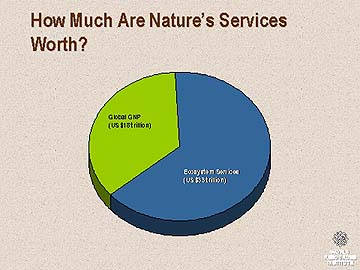![[Global Trends ]](/resources/Environment/Valuing%20Ecosystem%20Services_files/global-trends.gif)
|
Valuing Ecosystem Services
What are Mother Nature's life-support services worth? In one sense, their value is infinite. The Earth's economies would soon collapse without fertile soil, fresh water, breathable air, and an amenable climate. But "infinite" too often translates to “zero” in the equations that guide land use and policy decisions. Practitioners in the young field of ecological economics believe more concrete numbers are required to help nations avoid unsustainable economic choices that degrade both their natural resources and the vital services that healthy natural ecosystems generate. In one of the first efforts to calculate a global number, a team of researchers from the United States, Argentina, and the Netherlands has put an average price tag of US$33 trillion a year on these fundamental ecosystem services, which are largely taken for granted because they are free. That is nearly twice the value of the global gross national product (GNP) of US$18 trillion [1]. (See How Much Are Nature's Services Worth? and Ecosystems Services: Free, But Valuable.)
Even those involved in the study admit their number is a first approximation, but they consider it an essential starting point for further analysis and debate that will help nations overhaul their economic and environmental decisionmaking. Not everyone agrees with this approach, however. Some critics believe the effort to assign prices to ecosystem services is fundamentally flawed since these services can never be traded in open commerce, which is how prices of conventional goods and services are determined [2]. Others believe that, even if such prices can be reasonably calculated, they cannot reflect the full value of these services, which reaches well beyond their importance to the world economy. In fact, the study team also readily acknowledged that there are moral, ethical, and aesthetic reasons to value and protect nature quite apart from its benefits to humanity [3]. But the reality is that human societies put price tags on nature every day. Every land use decision involves implicit assumptions about value, even when no dollar figure is assigned. The problem is that the value of services provided by the Earth's ecological infrastructure does not fit into current economic equations, partly because most of the benefits fall outside the marketplace. Such services are public goods that contribute immeasurably to human welfare without ever being drawn into the money economy. For instance, the cycling of essential nutrients like nitrogen and phosphorus, which is not reflected in any nation's GNP, accounts for US$17 trillion of the US$33 trillion in annual ecosystem services, according to the study team's estimate [4]. Indeed, economic indicators such as GNP are increasingly recognized as flawed measures of both economic progress and sustainability, because they do not explicitly account for the degradation in ecological services that industry and commerce cause [5]. For example, valuing forests only for the marketable timber they produce, which is as much as the GNP can conveniently measure, ignores the many indirect costs that society bears when forests are logged: soil erosion, nutrient loss, increased flooding, declines in fisheries and water quality, reduced carbon storage capacity, changes in regional temperature and rainfall, and diminished wildlife habitat and recreational opportunities. There have been many attempts in the past few decades to estimate the value of various separate ecological services. The US$33 trillion calculation is a synthesis of results from more than 100 published studies using a variety of different valuation methods. In synthesizing these results, the research team looked at the value of 17 categories of services such as waste treatment, pollination, climate regulation, food production, and recreation in each of 16 types of ecosystems, from coastal estuaries to tropical forests, rangelands, lakes, and deserts. They calculated an average dollar value per hectare for each type of service in each ecosystem, then multiplied that dollar value by the total area each ecosystem type occupies on the globe [6]. This exercise clearly highlighted areas where much more work is needed. For some types of ecosystems, such as deserts, tundra, and croplands, so little is known that the valuation columns under nearly every ecological service remain blank [7]. That is one reason the study team considers the US$33 trillion a minimum value; it will likely increase as more ecological services are studied and the complex interactions among ecological processes are better understood. Values are also likely to increase as these services become more degraded and scarce in the future [8]. Whatever the eventual number, ecological economists consider the global dollar figure itself less important to policy than to the potential application of this valuation concept to local and regional land use decisions. Although the average value of wetland services may not be the same per hectare in Brazil, Indonesia, or Uganda, the very existence of the global estimates calculated in the study should broaden the context of local decisionmaking [9]. In fact, in a small but growing number of cases around the world, the benefits of proposed projects are being weighed against the social costs of lost ecosystem services. In some parts of the United States, for instance, attention is now focused on the benefits of protecting natural watersheds to assure safe and plentiful drinking water supplies, rather than on building expensive filtration plants to purify water from degraded watersheds. New York City recently found it could avoid spending US$6 billion to US$8 billion in constructing new water treatment plants by protecting the upstate watershed that has traditionally accomplished these purification services for free. Based on this economic assessment, the city invested US$1.5 billion in buying land around its reservoirs and instituting other protective measures, actions that will not only keep its water pure at a bargain price but also enhance recreation, wildlife habitat, and other ecological benefits [10]. In the traditionally prosperous Hadejia-Jama'are flood plain region in northern Nigeria, where more than one half of the wetlands have already been lost to drought and upstream dams, ecosystem valuation has been used to weigh the costs and benefits of proposals that would divert still more water away for irrigated agriculture. The net benefits of such a diversion priced out at US$29 per hectare. Yet, the intact flood plain already provides US$167 per hectare in benefits to a wider range of local people engaged in farming, fishing, grazing livestock, or gathering fuelwood and other wild products -- benefits that would be greatly diminished by the project. Thus, even without accounting for such services as wildlife habitat, the wetland is far more valuable to more people in its current state than diverted for irrigation [11]. Although ecological valuations like these are still rare, further development of the concept promises to provide a powerful tool for protection and sustainable use of natural ecosystems and the vital services they provide.
| |||||||||||||||||||||||||||||||||||
|
World Resources Institute, 10 G Street, NE (Suite 800), Washington, DC 20002 (202/729-7600; fax: 202/729-7610). For more information contact gregm@wri.org. |

